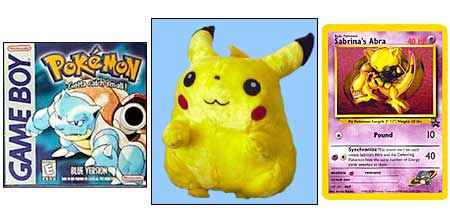Pokémon

Synopsis of Toy
As a kid in Japan, Satoshi Tajiri was big on two things: bug collecting and playing video games at the arcade. Years later, knee-deep in gaming culture and having founded a gaming magazine, Tajiri discovered Nintendo’s Game Boy. And what impressed him just as much as the hand-held game system itself was the fact that two Game Boys could be connected via a cord, and made to share information with each other. Tajiri spent six years crafting a Game Boy program, even though gaming technology had by that time shifted toward CD-ROMS. In 1996, a somewhat reluctant Nintendo bought the program, which was called Pokémon—short for pocket monsters and pronounced “poh-kay-mon.” It wasn’t too long before an international, multi-media craze ensued—from Japan to the rest of the world, from a Game Boy program to toys and cartoon shows and movies.
First, Pokémon beguiled elementary school children. In the game, the player (or “Trainer,” according to Pokémon lexicon), leads a lone adventurer on a quest to join the revered Pokémon League. But between the start of the game and that League admission, there’s a whole that the Trainer has to accomplish. First, the wild Pokémon creatures have to be caught (there are now over 250 of them), and then they have to be tamed. Each little guy has special abilities—there are fire Pokémon, flying Pokémon, bug Pokémon, etc., and when they are properly trained, the Pokémon on your team begin to do battle against other Pokémon, one at a time. The more “experience levels” that the each Pokémon gains, the more abilities and strength he acquires—he learns, in other words.
Unknown to Nintendo, creator Tajiri inserted a secret twist in the Pokémon programming—a little-seen monster known as Mew, who could only be caught when one Game Boy interacted with another via the link cord. The Mew mystery not only got early players talking excitedly amongst themselves, it also hooked new players into the Pokémon world. There were also four Pokémon creatures that reared their heads only when Trainers traded with other Trainers, and some Pokémon that didn’t evolve unless they were traded. All of it was incentive to play with and against friends, making good on Tajiri’s wish that his game have a distinct (and for the devoted, nearly unavoidable) multiplayer nature.
The game’s Trainers include Misty, Brock and Ash, the latter of whom had an infamously cute sidekick in the yellow thunder mouse Pikachu. Some Trainers are helpful, and some malicious. The game’s resident Pokémon expert is Professor Oak, who helps the newbies get started in the game. Other well-known Pokémon are Grimer, Squirtle Beedrill, Pidgeotto, Jigglypuff, Squirtle and Snorlax. In the same way that Trainers have different personalities, so do these—some are just adorable, and some quite scary.
Nintendo followed the success of the Game Boy game with trading cards and comics, then a Pokémon cartoon series in 1997. The following year, the game and the cartoon were brought to the U.S. Both of these, as well as the Pokémon trading cards and related toy merchandise, including books and plush toys, were huge hits. The only problem was, some parents didn’t understand the odd and sometimes militaristic language inherent to Pokémon. But it did help a bit when the games finally received approval from the National Parenting Center and the Vatican, which is indicative of how internationally popular the game had become.
Nintendo now has well over a hundred companies licensing more than a thousand Pokémon products, and their dollar sales are in the several billions. Hasbro bought market rights in the U.S., and they’ve probably never been sorry, because the trading cards are wildly successful here.
It’s much more than a Game Boy program or a stuffed monster at this point. It’s a whole world that a kid, or a grown-up kid, can immerse himself in…full of quest possibilities, role-playing and interactive challenge. All this from a guy whose childhood penchant for dead beetles and Space Invaders convinced his parents he had no vocational hope at all.
Release History of Toy
1996 - Pokémon Gameboy gameSub Categories of Toys
gameselectronic games
hobbies
